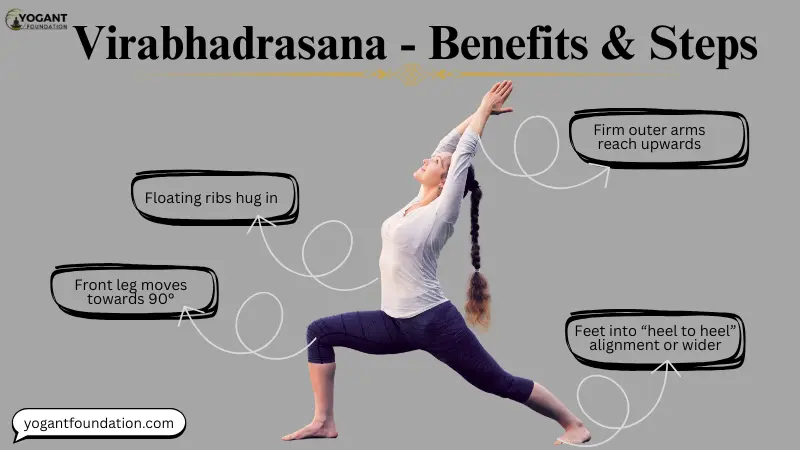What is Virabhadrasana?
Virabhadrasana (Warrior Pose), is one of the most famous and strong standing poses in yoga.
It is a symbol of endurance, strength and focus, all of which have their roots in the mythological roots.
You can practice the pose in different forms (I, II, and III). It helps improve physical endurance and mental strength. This makes it a popular choice for Hatha and Ashtanga Yoga. Etymology of “Virabhadrasana”.
The word Virabhadrasana comes from Sanskrit components like:
- Vira is a symbol of “hero” or “warrior“
- Bhadra, which means “friend” or “auspicious“
- Asana It is a translation into “pose“
This posture is named in honor of the powerful warrior. Believed As per Hindu mythology was made by the god of Hinduism, Lord Shiva. Each variation shows a different position taken by the godly warrior who is engaged in battle.
In Hindi, what is Virabhadrasana? वीरभद्रासन क्या है?
जिसे अंग्रेजी में Warrior Pose कहा जाता है, एक शक्तिशाली और स्थिर योगासन है| यह आसन योग में वीरता, शक्ति और संतुलन का प् प्रतीक है। “वीरभद्र” भगवान शिव क्रोध से उत्पन्न योद्धा रूप का अर्थ है मुद्रा१ यह आसन शरीर में विश्वास और संतुलन लाने में सहायक होता है|
वीरभद्रासन की तीन प्रमुख अवस्थाएँ होती हैं:
1. Warrior Pose I (वीरभद्रासन I)
2. Warrior Pose II (वीरभद्रासन II)
3. Warrior Pose III (वीरभद्रासन III)
इन तीनों रूपों में शरीर की मुद्रा, संतुलन, लचीलापन और एकाग्रता पर काम किया जाता है।
Types of Virabhadrasana
It is known as the Warrior Pose has three primary types:
1. Virabhadrasana I (Warrior I)
It is a pose that has the solid and stable posture and arms that are lifted up over the shoulders.
2. Virabhadrasana II (Warrior II)
In this version, the arms are stretched out to the sides. The palms face each other, and the eyes look forward.
3. Virabhadrasana III (Warrior III)
It is an advanced standing posture that balances the torso and one leg are parallel to the ground.
Each one of them has specific advantages, stimulates different muscles and improves determination and courage.
How to do Virabhadrasana I, II, III
Perform Virabhadrasana I
Step 1: Begin with Mountain Pose (Tadasana)
Straighten your body with your feet in a straight line with your arms by your side. You can take a deep breath and allow your shoulders to lower.
Step 2: Widen Your Stance
Step your right foot about 3-4 feet.
Turn your left foot towards the back around 45 degrees.
Step 3: Flex the Front Knee
Bend your right knee to place it right above your ankle.
Keep your left leg open and firmly engaged.
Step 4: Elevate Your Arms
Take a deep breath and raise the arms over your head. Check that the palms point towards one the other, or stay near.
Make sure your shoulders are at a comfortable level and away from your ears.
Step 5: Look Upward
Slowly move your head, focusing upon your hands. Make sure your chest is open, and make sure your spine is fully extended.
Step 6: Maintain the Pose and Breathe
Keep this posture for 5-10 deep breaths.
Exhale, lower your arms, and come back into Mountain Pose.
Step 7: Switch Sides
Move forward using your left foot. Repeat the same pose.
Perform Virabhadrasana II
Step 1: Start with Mountain Pose
Stand up straight and keep your body in a balanced position.
Step 2: Take a Wide Stance
Take your feet off about four feet.
Your right foot should be rotated inwards by 90 degrees. Turn your left foot towards the back slightly.
Step 3: Bend the Front Leg
You can flex your right knee, it’s just above your ankle.
Maintain a solid upright posture using your leg to the left.
Step 4: Extend Your Arms
Extend your arms in a straight line parallel to the ground and your palms facing down.
Be sure that your shoulders stay in a relaxed position.
Step 5: Focus on the Front Hand
You can turn your head and glance over to your right hand.
Make sure your torso is aligned and your spine lengthened.
Step 6: Sustain the Position
You can hold this posture for between 5 and 8 minutes.
Return to your starting place and repeat with the other side.
Perform Virabhadrasana III
Step 1: Begin in Warrior I Position
Begin by putting your right foot on the floor to Virabhadrasana I.
Step 2: Shift Your Weight Forward
Lean forward into the posture and slowly raise your back leg from the floor.
Step 3: Align Your Body
Straighten your arms towards the front (or along you).
Make sure your arms, torso and leg are in an even line with respect with the floor.
Step 4: Find Your Balance
Maintain your hips in alignment to the floor.
Engage your core muscles to keep your stability.
Step 5: Maintain and Transition
Stay in this position for 5 breaths and slowly returning to a standing position.
Repeat the procedure with the opposite hand.
Benefits of Virabhadrasana
1. Muscle Development
The exercise strengthens the muscles of the arms, legs shoulders, back and. It tones and shapes the calves, glutes and the thighs.
2. Balance and Coordination Improvement
Enhances physical balance and improves coordination.
This is beneficial for Warrior III, which tests the core stability and concentration.
3. Flexibility Enhancement
The hips are opened up and the chest area.
Stretches the legs, groin and ankles.
4. Stamina and Endurance Boost
Maintaining the pose will increase the endurance of your muscles.
It improves circulation, and energizes the body.
5. Mental Clarity Enhancement
It helps to increase mental clarity and self-discipline, determination and resolution.
The imagery of the warrior builds confidence and confidence and inner determination.
6. Therapeutic Advantages
Aids in alleviating sciatica symptoms.
Improves posture and alignment of the spine.
It encourages breathing deeper and increases the capacity of your lung.
Precautions and Contraindications
Virabhadrasana has many benefits. It is important to practice it safely. Be aware of these safety precautions:
1. Injuries to the Knee or Ankle
Anyone who is experiencing joint injuries or pains must avoid doing deep lunges.
Using props or seek guidance into practice.
2. Hypertension
It is recommended to reduce the time spent doing the posture.
You are playing Warrior I. Straight arms to the floor and not lift the arms to ceiling.
3. Cardiac Conditions
Heart problems – It is best to talk to a healthcare expert or a yoga instructor ahead starting yoga.
4. Balance issues
The game Warrior III requires good balance. Beginners may find it helpful to use a chair or wall for support.
5. Spinal Concerns
You suffer from disc injuries or spinal injury Avoid deep back bends.
6. Pregnancy
You are in the stage pregnant. It’s advisable to avoid the more advanced forms of pregnancy.
Always do your yoga under the guidance of a prenatal yoga certified instructor.
Tips for Beginners
Do not allow the front knee to stretch past the ankle.
Your hips are in the correct position, in Warrior I and III poses. Use of yoga blocks for extra stability doing Warrior III.
Focus on keeping your breath steady to help maintain your alignment, and to promote peace.
Conclusion
Virabhadrasana often referred to by The Warrior Pose, is a pose that blends physical strength with mental fortitude.
Every variation of this posture encourages elegance, poise and confidence in oneself.
No matter, you are doing Hatha Yoga, Ashtanga Yoga, or a Vinyasa flow, Warrior Poses can help. They can improve your practice and increase your body awareness.
The warrior spirit is strong. Virabhadrasana will inspire us to face every challenge with determination, stability, and power.



